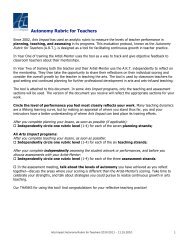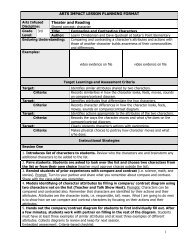Dance and Writing.pdf - Arts Impact
Dance and Writing.pdf - Arts Impact
Dance and Writing.pdf - Arts Impact
Create successful ePaper yourself
Turn your PDF publications into a flip-book with our unique Google optimized e-Paper software.
ARTS IMPACT LESSON PLANNING FORMAT<br />
<strong>Arts</strong>/Other Core<br />
Discipline:<br />
<strong>Dance</strong> <strong>and</strong> <strong>Writing</strong><br />
Grade 4<br />
Title: Beginning, Middle, End: <strong>Dance</strong>/<strong>Writing</strong> Connection<br />
Level:<br />
Author: Krissy Thorvilson with Debbie Gilbert, at Sunnyside ES, Marysville<br />
Enduring Underst<strong>and</strong>ing:<br />
Examples:<br />
<strong>Dance</strong> performances <strong>and</strong> narratives in writing include a beginning,<br />
middle, <strong>and</strong> end.<br />
Begins in an exaggerated shape. Repeats the beginning exaggerated<br />
shape.<br />
Target Learnings <strong>and</strong> Assessment Criteria<br />
Target: Moves using strong <strong>and</strong> light energy.<br />
Criteria: Uses the body to show powerful <strong>and</strong> delicate movements.<br />
Target: Creates a beginning of a dance with dramatic, attention-grabbing<br />
shape <strong>and</strong> movement.<br />
Criteria: Begins in an exaggerated shape <strong>and</strong> moves with strong/powerful<br />
energy.<br />
Target: Creates a middle of a dance by choosing from a variety of previously<br />
introduced dance movements.<br />
Criteria: Uses the body to show a movement phrase with either levels,<br />
directions, <strong>and</strong>/or self <strong>and</strong> general space.<br />
Target: Creates an ending of a dance with calm <strong>and</strong> restrained movement.<br />
Criteria: Moves with a light/delicate energy <strong>and</strong> repeats the beginning<br />
exaggerated shape.<br />
Instructional Strategies<br />
1. Leads the warm-up with the Brain<strong>Dance</strong>. Points out using strong <strong>and</strong> light energy during<br />
selected parts of the Brain<strong>Dance</strong>. Reviews levels, directions, <strong>and</strong> self/general space during<br />
Brain<strong>Dance</strong>.<br />
2. Introduces strong <strong>and</strong> light energy. Asks the students what a strong voice sounds like.<br />
Introduces words like dramatic, attention-grabbing, <strong>and</strong> powerful. Asks students what a light voice<br />
sounds like. Introduces words like delicate, calm, restrained. Guides students to show examples of<br />
both strong <strong>and</strong> light voices.<br />
3. Connects voice concepts with movement. Demonstrates several strong movements. Prompt:<br />
How do you know movements are dramatic, attention-grabbing, powerful? Demonstrates several light<br />
movements. Prompt: How do you know movements are delicate, calm, restrained?<br />
4. Establishes a signal for strong, <strong>and</strong> a signal for light movement <strong>and</strong> explores concepts.<br />
Asks the students to move in self space <strong>and</strong> shows the appropriate movements with the signals.<br />
Guides students to move in general space showing the appropriate movements with the signals.<br />
Embedded Assessment: Teacher Checklist.<br />
1
5. Introduces the plan for choreographing a dance with a beginning, middle, <strong>and</strong> end.<br />
Prompt: A dance is like a story it has a beginning, middle, <strong>and</strong> end.<br />
6. Prompt: How should a piece of writing begin? Guides students to recognize a beginning<br />
should be powerful <strong>and</strong> attention-grabbing. Prompt: In writing we use a hook (lead sentence).<br />
In dance we can use strong movements. Asks students in pairs to create a strong shape, <strong>and</strong> a short<br />
phrase of strong movement.<br />
7. Introduces the middle. Reviews the terms levels, directions, <strong>and</strong> self <strong>and</strong> general space.<br />
Prompts: In writing the middle is the longest part in which to express yourself. You have all the words<br />
in the world, <strong>and</strong> you have to choose what you want to say. I want you to use what we’ve learned to<br />
create the middle of your dance using some or all of our dance vocabulary. Pairs students to create<br />
their middle phrase.<br />
8. Introduces the end. Students sit. Guides students to discuss the end of a piece of writing.<br />
Prompt: How does it feel? (wrapped –up, connected to the beginning, feels like it time to stop)<br />
Connects these concepts with dance movements. Prompt: What kind of energy will make the dance<br />
feel like it’s coming to an end? (light energy) So we’ll start out with strong energy <strong>and</strong> we’ll end with<br />
light energy. Students create a light ending phrase.<br />
9. Guides students in creating beginning <strong>and</strong> ending shape. Prompts: When you end a piece of<br />
writing you restate your topic or your thesis sentence. For this dance you <strong>and</strong> your partner should end<br />
in (repeat) the same shape in which you started the dance. Everyone show me the shape you created<br />
for the beginning of your dance. This is the shape you will be in when the music starts, <strong>and</strong> the shape<br />
you will be in at the end of your dance.<br />
10. Guides students in rehearsal. Prompt: Now that you have your three sections, the beginning,<br />
middle, <strong>and</strong> end, rehearse your dance with your partner several time.<br />
Embedded Assessment: Teacher Checklist<br />
11. Divides the student pairs into three groups for performance <strong>and</strong> response. Asks each<br />
group to perform, while the other two are audience. Asks the audience to give feedback.<br />
Prompts: What did you see in the beginning, what did you see in the middle, what did you see in the<br />
end of the dance? Embedded Assessment: Peer Assessment<br />
12. Wraps-up the lesson with the statement: Prompt: A dance performance, like a piece of<br />
writing, has a beginning, middle, <strong>and</strong> end.<br />
2
Vocabulary Resources:<br />
Historical Art or<br />
Performance<br />
• beginning<br />
• direction<br />
• end<br />
• levels<br />
• light/delicate<br />
energy<br />
• middle<br />
• movement phrase<br />
• repetition<br />
• self <strong>and</strong> general<br />
space<br />
• shape<br />
• strong/powerful<br />
energy<br />
The Pilobolus, World<br />
<strong>Dance</strong> Series, Seattle<br />
Scheduled Study<br />
Visit: Enter the DATE<br />
of your study visit.<br />
Classroom, Visual<br />
<strong>Arts</strong> or Performing<br />
<strong>Arts</strong> Materials<br />
• Word cards:<br />
beginning, middle,<br />
end, energy, levels,<br />
direction(s), self<br />
<strong>and</strong> general Space<br />
• Eric Chappelle,<br />
Music for Creative<br />
<strong>Dance</strong> Vol. I<br />
WA Essential<br />
Learnings<br />
AEL 1.1 concepts:<br />
• levels<br />
• self <strong>and</strong> general<br />
space<br />
• shape, repetition<br />
• energy<br />
AEL 1.1.2 composition<br />
• creates strong <strong>and</strong><br />
light movement<br />
(energy)<br />
• creates movement<br />
sequences with a<br />
beginning, middle,<br />
<strong>and</strong> end AND<br />
improvises<br />
movement using<br />
the elements of<br />
dance<br />
AEL 1.2 skills <strong>and</strong><br />
techniques:<br />
• performs sequences<br />
of movement from<br />
memory<br />
AEL 2.2 Applies a<br />
performance process:<br />
• rehearses <strong>and</strong><br />
performs<br />
AEL 4.2 demonstrates<br />
<strong>and</strong> analyzes the<br />
connections between<br />
the arts <strong>and</strong> other<br />
content areas<br />
• writing<br />
3
<strong>Arts</strong> Discipline: <strong>Dance</strong> <strong>and</strong> <strong>Writing</strong><br />
Grade 4 Title: Beginning, Middle, End: <strong>Dance</strong>/<strong>Writing</strong> Connection<br />
Level:<br />
Author: Krissy Thorvilson with Debbie Gilbert, at Sunnyside ES, Marysville<br />
Students<br />
Energy Shape/Energy Movement Energy/Shape Total<br />
Points<br />
4<br />
1.<br />
2.<br />
3.<br />
4.<br />
5.<br />
6.<br />
7.<br />
8.<br />
9.<br />
10.<br />
11.<br />
12.<br />
13.<br />
14.<br />
15.<br />
16.<br />
17.<br />
18.<br />
19.<br />
20.<br />
21.<br />
22.<br />
23.<br />
24.<br />
25.<br />
Total<br />
Percentage<br />
Uses the body<br />
to show<br />
powerful <strong>and</strong><br />
delicate<br />
movements<br />
Beginning<br />
Begins in an<br />
exaggerated shape <strong>and</strong><br />
moves with<br />
strong/powerful energy<br />
Middle<br />
Uses the body to show<br />
a movement phrase<br />
with either levels,<br />
directions, <strong>and</strong>/or self<br />
<strong>and</strong> general space<br />
End<br />
Moves with a<br />
light/delicate energy<br />
<strong>and</strong> repeats the<br />
beginning<br />
exaggerated shape<br />
4
Teacher Comments<br />
Were there any students especially<br />
challenged by concepts in the<br />
lesson; what instructional strategies<br />
helped these students?<br />
Were there lesson dynamics that<br />
helped or hindered learning?<br />
What classroom management<br />
techniques supported student<br />
learning?<br />
Other comments:<br />
Family Communication: Key thoughts in communication to family: learned <strong>and</strong><br />
demonstrated powerful <strong>and</strong> delicate movements; created a<br />
powerful (exaggerated) shape for the beginning <strong>and</strong> the end of a<br />
dance; created movement with powerful <strong>and</strong> delicate movements,<br />
created a movement phrase to show the middle of a dance.<br />
5
















